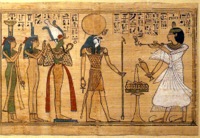Papyrus
Origin
Middle English, via Latin from Greek papuros — see also paper
The English word "papyrus" derives, via Latin, from Greek πάπυρος (papuros),[12] a loanword of unknown (perhaps Pre-Greek) origin. Greek has a second word for it, βύβλος (bublos] said to derive from the name of the Phoenician city of Byblos). The Greek writer Theophrastus, who flourished during the 4th century BC, uses papuros when referring to the plant used as a foodstuff and bublos for the same plant when used for nonfood products, such as cordage, basketry, or writing surfaces. The more specific term βίβλος biblos, which finds its way into English in such words as 'bibliography', 'bibliophile', and 'bible', refers to the inner bark of the papyrus plant. Papyrus is also the etymon of 'paper', a similar substance. In the Egyptian language, papyrus was known by the terms wadj (w3ḏ), tjufy (ṯwfy), and djet (ḏt).
Definitions
- 1a. a material prepared in [ancient Egypt from the pithy stem of a water plant, used in sheets throughout the ancient Mediterranean world for writing or painting on and also for making rope, sandals, and boats.
2 the tall aquatic sedge from which papyrus is obtained, native to central Africa and the Nile valley.
Description
Papyrus is a thin paper-like material made from the pith of the papyrus plant, Cyperus papyrus, a wetland sedge that was once abundant in the Sudd of Southern Sudan along with the Nile Delta of Egypt. Papyrus is first known to have been used in ancient Egypt (at least as far back as the First Dynasty), but it was also used throughout the Mediterranean region and in Kingdom of Kush. Ancient Egyptians are thought to have used papyrus as a writing material, as well as employing it commonly in the construction of other artifacts such as reed boats, mats, rope, sandals, and baskets.
Papyrus was first manufactured in Egypt and Southern Sudan as far back as the fourth millennium BCE.[3][not in citation given][4] The earliest archaeological evidence of papyrus was excavated in 2012-2013 at Wadi al-Jarf, an ancient Egyptian harbor located on the Red Sea coast. These documents date from ca. 2560–2550 BCE (end of the reign of Khufu).[3] In the first centuries BCE and CE, papyrus scrolls gained a rival as a writing surface in the form of parchment, which was prepared from animal skins. Sheets of parchment were folded to form quires from which book-form codices were fashioned. Early Christian writers soon adopted the codex form, and in the Græco-Roman world, it became common to cut sheets from papyrus rolls to form codices.
Codices were an improvement on the papyrus scroll, as the papyrus was not pliable enough to fold without cracking and a long roll, or scroll, was required to create large-volume texts. Papyrus had the advantage of being relatively cheap and easy to produce, but it was fragile and susceptible to both moisture and excessive dryness. Unless the papyrus was of perfect quality, the writing surface was irregular, and the range of media that could be used was also limited.
Papyrus was replaced in Europe by the cheaper, locally produced products parchment and vellum, of significantly higher durability in moist climates, though Henri Pirenne's connection of its disappearance with the Muslim overrunning of Egypt is contended. Its last appearance in the Merovingian chancery is with a document of 692, though it was known in Gaul until the middle of the following century. The latest certain dates for the use of papyrus are 1057 for a papal decree (typically conservative, all papal bulls were on papyrus until 1022), under Pope Victor II, and 1087 for an Arabic document. Its use in Egypt continued until it was replaced by more inexpensive paper introduced by Arabs. By the 12th century, parchment and paper were in use in the Byzantine Empire, but papyrus was still an option. Papyrus was made in several qualities and prices; these are listed, with minor differences, both by Pliny and Isidore of Seville.
Until the middle of the 19th century, only some isolated documents written on papyrus were known. They did not contain literary works. The first discovery of papyri rolls in modern days was made at Herculaneum in 1752. Before that date, the only papyri known were a few surviving from medieval times.[1]
